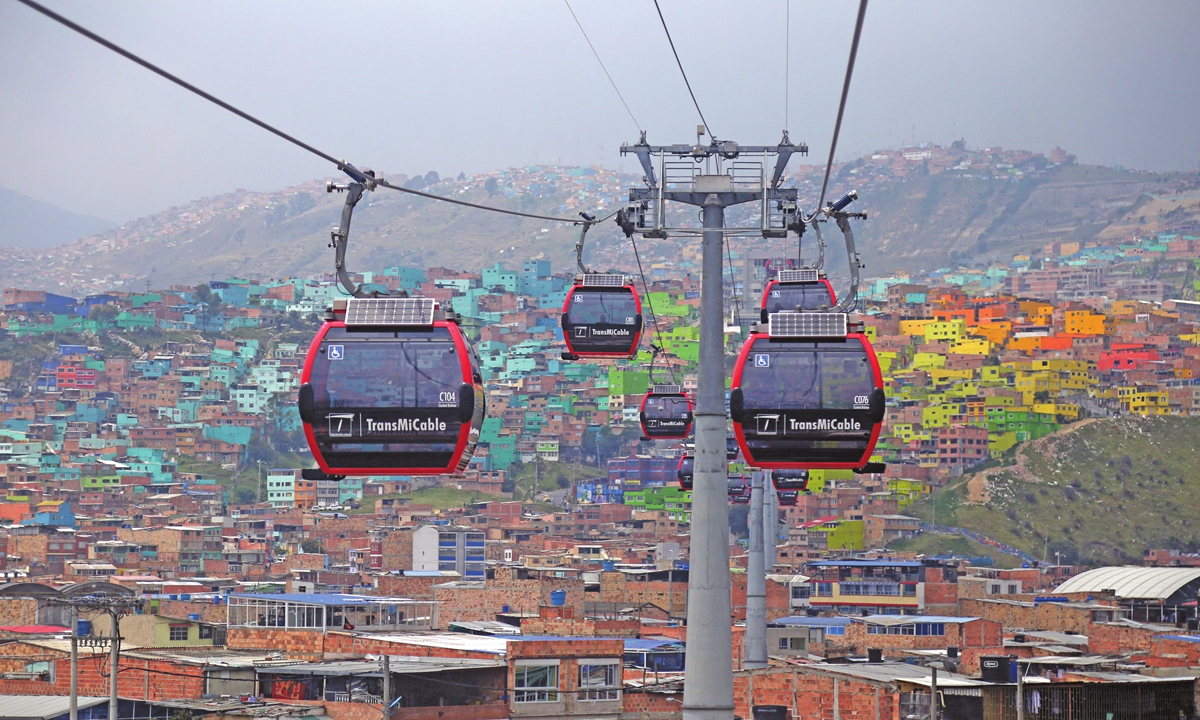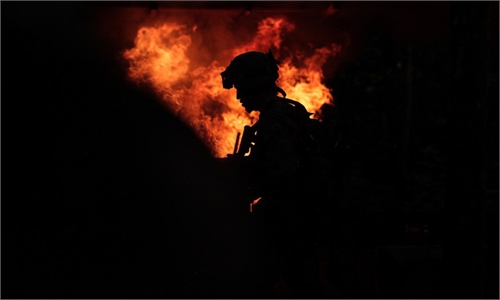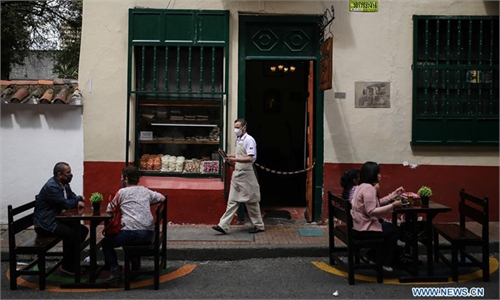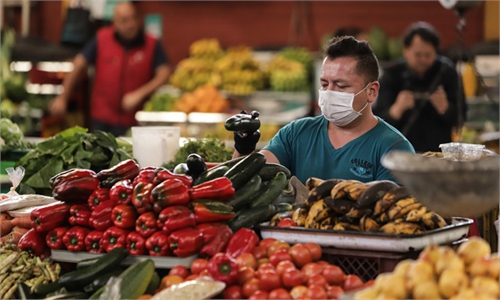When Colombian community leader Veronica Fonseca raised her hand to speak at a meeting hosted by Bogota's mayor, she never expected her ideas on improving transport in the capital would be included in the city's plans.

"I'd seen cable car lines working in other areas of the city and I told the mayor that's what our community needs too," said Fonseca, outside her home in the steep San Dionisio neighborhood surrounded by forested mountains. When officials added her suggestion to their plans, "I felt included. I never imagined that my ideas would be taken into account," she told Reuters.
Fonseca is one of 50,000 residents who have contributed to plans to redesign a 23-kilometer, car-choked major thoroughfare through the capital. Most had their say in dozens of meetings, online or through door-to-door surveys carried out by city hall.
The "Green Corridor Septima" initiative is a flagship project of Bogota's first female mayor, Claudia Lopez, and aims to better integrate the city's transport network, part of a broader effort to cut climate-changing emissions and pollution.
She and other officials see shifting residents towards low-carbon travel as a key pillar of the city's climate and development strategy.
'Listened a lot'
In Bogota, transport accounts for nearly half of all greenhouse gas emissions. To slash those, officials are expanding bike lanes and pedestrian paths, using more electric buses, and extending the reach of electric cable cars - some partly driven by renewable solar power - that serve poor areas in the city's south. Many of the ideas have come from residents, whose views were collected and prioritized as a core part of the $620 million Green Corridor Septima plan.
Juan Pablo Caicedo, head of the project led by the Institute of Urban Development, said the city first "listened a lot" to a diverse range of city dwellers, from LGBTQ+ residents and the elderly to Afro-Colombians and indigenous people.
Residents were consulted in part through an open-source online platform that allowed people to submit their ideas by editing and adding to draft plans.
The effort ultimately drew 7,000 proposals from citizens, some as young as 10 years old.
Trucker battles
Greening transport remains one of Bogota's biggest challenges on its path to net-zero emissions.
Fossil fuel-powered cars, buses, and cargo trucks - some belching black clouds of smoke - emit a big share of the 14,000 tons of carbon dioxide entering Bogota's atmosphere daily, according to Carolina Urrutia, the city's environment secretary.
With no nationwide railway system, goods and food are mainly transported by trucks traversing Colombia's high Andean mountains. But efforts to get truck drivers and private bus companies to switch to lower-carbon energy always spark a "heated debate," admitted Urrutia.
Numerous attempts by previous mayors to rid Bogota of old polluting buses have met with strikes and street protests by bus and driver groups - and ultimately city hall has backed down.
Electric buses
Bogota is also boosting its use of electric buses, said Felipe Ramirez, who heads the city's Transmilenio bus system.
Bogota now has about 350 electric buses circulating, used by about 180,000 people a day. It plans to roll out 1,485 such buses by 2022, which would give it the largest city fleet outside of China, he said.
"Despite the pandemic, we're on schedule," said Ramirez, showing off a newly-built charging station near the airport, its parking area blissfully quiet compared to the usually thrumming bus terminals.
The city's electric bus fleet reduces emissions equivalent to taking 42,000 cars off the road each year, Ramirez said, and offers the latest technology, from phone-charging to free Wi-Fi. Under public tenders through state-owned Transmilenio, private bus firms buy and operate the electric fleet in exchange for 15-year concessions.
Bicycle school
At a spacious new school in the poor neighborhood of Bosa, in south Bogota, the staff is encouraging a new generation to take up low-carbon transport.
"The Bike College," which fully opened in February, aims to put the bicycle at the center of education, said head teacher Jose Willington.
"Riding a bike gives students an equal status" to those living outside the slums, he noted.
On a sports court at the school, which serves more than a 1,000 primary and high-school students, some children learned about road safety from instructors, while others practiced riding their bicycles, wobbling along. Even before the pandemic, Bogota was crisscrossed by a 550-kilometer network of cycle lanes, the longest in Latin America.
The city added another 80 kilometers of lanes at the start of the pandemic, to ease crowding on buses, and plans 280 kilometers more by 2024.
At the bike college, older students learn to repair high-end and electric bikes, make sportswear and build road safety apps and can earn a qualification in bicycle mechanics alongside a high-school diploma.

Cable cars are seen in Bogota, Colombia, on March 19, 2020. Photo: AFP
Fonseca, 52, told a forum convened by city hall in 2020 that her hilltop neighborhood, nearly 3,000 meters above downtown Bogota, needed better transport links, and suggested a cable car to ferry residents."I'd seen cable car lines working in other areas of the city and I told the mayor that's what our community needs too," said Fonseca, outside her home in the steep San Dionisio neighborhood surrounded by forested mountains. When officials added her suggestion to their plans, "I felt included. I never imagined that my ideas would be taken into account," she told Reuters.
Fonseca is one of 50,000 residents who have contributed to plans to redesign a 23-kilometer, car-choked major thoroughfare through the capital. Most had their say in dozens of meetings, online or through door-to-door surveys carried out by city hall.
The "Green Corridor Septima" initiative is a flagship project of Bogota's first female mayor, Claudia Lopez, and aims to better integrate the city's transport network, part of a broader effort to cut climate-changing emissions and pollution.
She and other officials see shifting residents towards low-carbon travel as a key pillar of the city's climate and development strategy.
'Listened a lot'
In Bogota, transport accounts for nearly half of all greenhouse gas emissions. To slash those, officials are expanding bike lanes and pedestrian paths, using more electric buses, and extending the reach of electric cable cars - some partly driven by renewable solar power - that serve poor areas in the city's south. Many of the ideas have come from residents, whose views were collected and prioritized as a core part of the $620 million Green Corridor Septima plan.
Juan Pablo Caicedo, head of the project led by the Institute of Urban Development, said the city first "listened a lot" to a diverse range of city dwellers, from LGBTQ+ residents and the elderly to Afro-Colombians and indigenous people.
Residents were consulted in part through an open-source online platform that allowed people to submit their ideas by editing and adding to draft plans.
The effort ultimately drew 7,000 proposals from citizens, some as young as 10 years old.
Trucker battles
Greening transport remains one of Bogota's biggest challenges on its path to net-zero emissions.
Fossil fuel-powered cars, buses, and cargo trucks - some belching black clouds of smoke - emit a big share of the 14,000 tons of carbon dioxide entering Bogota's atmosphere daily, according to Carolina Urrutia, the city's environment secretary.
With no nationwide railway system, goods and food are mainly transported by trucks traversing Colombia's high Andean mountains. But efforts to get truck drivers and private bus companies to switch to lower-carbon energy always spark a "heated debate," admitted Urrutia.
Numerous attempts by previous mayors to rid Bogota of old polluting buses have met with strikes and street protests by bus and driver groups - and ultimately city hall has backed down.
Electric buses
Bogota is also boosting its use of electric buses, said Felipe Ramirez, who heads the city's Transmilenio bus system.
Bogota now has about 350 electric buses circulating, used by about 180,000 people a day. It plans to roll out 1,485 such buses by 2022, which would give it the largest city fleet outside of China, he said.
"Despite the pandemic, we're on schedule," said Ramirez, showing off a newly-built charging station near the airport, its parking area blissfully quiet compared to the usually thrumming bus terminals.
The city's electric bus fleet reduces emissions equivalent to taking 42,000 cars off the road each year, Ramirez said, and offers the latest technology, from phone-charging to free Wi-Fi. Under public tenders through state-owned Transmilenio, private bus firms buy and operate the electric fleet in exchange for 15-year concessions.
Bicycle school
At a spacious new school in the poor neighborhood of Bosa, in south Bogota, the staff is encouraging a new generation to take up low-carbon transport.
"The Bike College," which fully opened in February, aims to put the bicycle at the center of education, said head teacher Jose Willington.
"Riding a bike gives students an equal status" to those living outside the slums, he noted.
On a sports court at the school, which serves more than a 1,000 primary and high-school students, some children learned about road safety from instructors, while others practiced riding their bicycles, wobbling along. Even before the pandemic, Bogota was crisscrossed by a 550-kilometer network of cycle lanes, the longest in Latin America.
The city added another 80 kilometers of lanes at the start of the pandemic, to ease crowding on buses, and plans 280 kilometers more by 2024.
At the bike college, older students learn to repair high-end and electric bikes, make sportswear and build road safety apps and can earn a qualification in bicycle mechanics alongside a high-school diploma.




